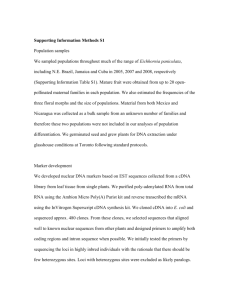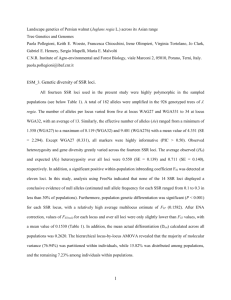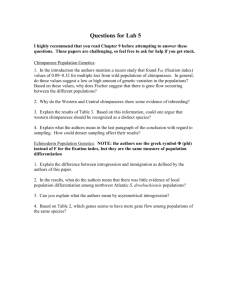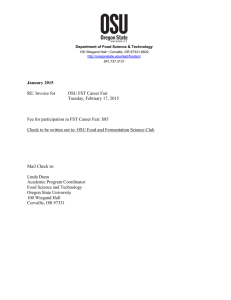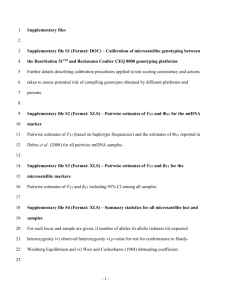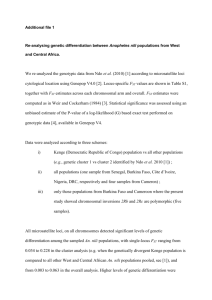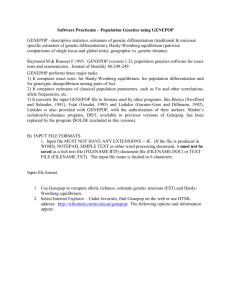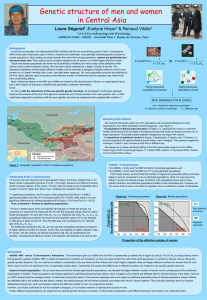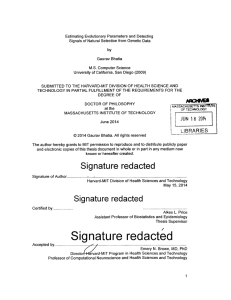Slides
advertisement
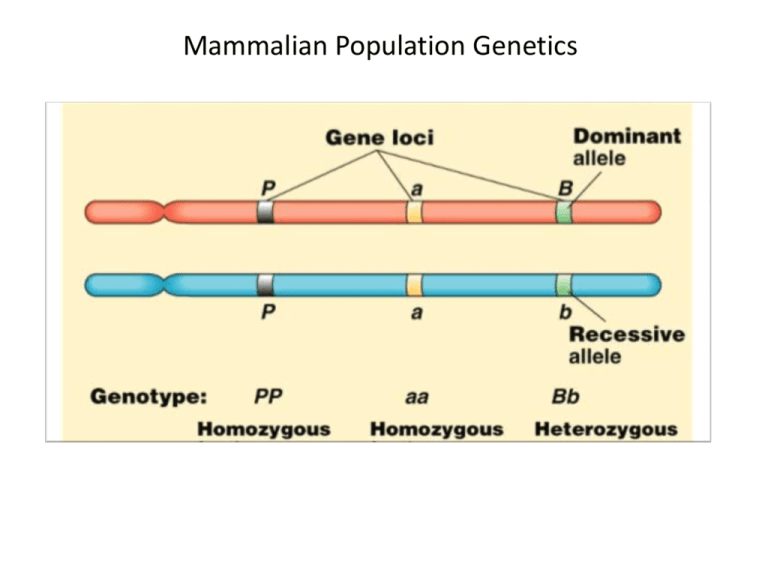
Mammalian Population Genetics Allele Frequencies The total number of copies of an allele divided by (for mammals) 2N. Aa AA aa Aa AA aa Aa Aa Aa Aa AA aa AA p = 14/26 = 0.53; q = 12/26 = 0.47 Heterozygosity – Index of Genetic Diversity Individual Population Aa AA aa Aa Aa AA BB aa Aa cc Aa Aa Dd Aa AA HI – The percentage of loci at which an individual is heterozygous HI = 0.5 HP – The average heterozygosity in a population. HP = 0.461 For multiple loci we average across loci . aa AA Several Factors Influence Genetic Diversity 1) Mutation Rate – this is the rate that new variants are generated and usually is fairly constant. 2) Demographic History – Populations that have recently either expanded or contracted tend to have low diversity; stable populations tend to have relatively higher diversity. 3) Genetic Drift – The random sampling of parental alleles can lead to decreased diversity. This is especially a factor for small populations, so small populations tend to drift to low diversity. 4) Migration – Populations that receive a lot of immigrants tend to have high diversity. Population Differentiation How strongly differentiated are two (or more) populations? FST – Fixation index – First developed by Wright decades ago. 1) The correlation of randomly chosen alleles within the same population relative to the entire set of populations. 2) The proportion of genetic diversity in a sample that’s attributable to allele frequency differences among or between populations. The fixation indices (FST and its analogues: RST, GST, fST) are really flexible, in that they allow us to evaluate several processes relevant to molecular ecology. An excellent recent overview is provided by Holsinger & Weir (2009. Nat. Rev. Gen. 10:639). http://digitalcommons.uconn.edu/eeb_articles/22/ Population Differentiation Example: mule deer (Odocoileus hemionus) subspecies. O. h. hemionus Latch et al. (2014. Mol. Ecol. 23:3171) estimated genetic differentiation among these using microsatellite data. O. h. columbianus ΦST = 0.224 There’s strong differentiation among these three subspecies. O. h. sitkensis This probably represents Pleistocene refugia. Applications of Fixation Indices Migration / Gene Flow One of the classic equations in population genetics relates gene flow (migration) to FST. FST ~~ 1/(4Nem +1) So Nem » 1- FST 4FST Ne is the effective population size & m is the fraction of each population that are migrants. Assumptions: Infinite number of populations. Same Ne in each population. Island model of migration. Fantasy Island Model Applications of Fixation Indices Migration/Gene Flow & Landscape Genetics What landscape features influence gene flow? Cervus elephas in Scotland Most of the variation in FST is explained by distance between populations: Isolation-by-Distance. Some population pairs that don’t fit I-b-D predictions. These are separated by lakes, not roads, as might be predicted. Perez-Espona et al., 2008. Mol. Ecol., 17:981 Applications of Fixation Indices Detecting selection – Outlier FST FST can be calculated for each locus (just like HP). We can scan the genome to look for outlier loci that show unusual level of differentiation. Locus 3 is an outlier. Applications of Fixation Indices Detecting selection Storz, J. 2005. Mol. Ecol. 14:671 Peromyscus maniculatus The albumin gene is subject of selection in high elevation populations. Identification of management units and tests of taxonomy. Preble’s meadow jumping mouse – Zapus hudsonius preblei. Listed under the ESA. Z. h. campestris Z. h. preblei Z. h. pallidus Z. h. luteus Ramey et al. (2005) recommended delisting. Figure from Ramey et al. (2005). Identification of management units and tests of taxonomy. Data from King et al. (2006) Identification of Mating Systems Microsats are often variable enough for use in paternity analysis. Exclusion Analysis Locus A Two loci with multiple alleles Locus A 100 102 104 106 108 Locus B 230 232 234 236 238 Locus B Pup: 100 – 106 232 - 234 Male 1: 100 – 108 230 - 236 Male 2: 104 – 106 234 - 236 Male 3: 102 – 108 232 - 234 Male 4: 108 – 108 230 - 234 Male 5: 104 – 108 230 - 238 Identification of Mating Systems Antilocapra americana Monestrous: estrus occurs one night per year. Females wander through several males' territories and engage in courtship chases. Based on observations of behavior, it was thought that females mated only once. Females produce twins, so it’s easy enough to see if the twins have the same fathers. It turns our that 11 of 25 sets of twins have different fathers.
